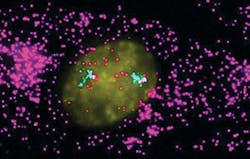NEUROSCIENCE/GENETICS/ONCOLOGY: NIH funds development of optogenetics and imaging approaches
Among those the National Institutes of Health (NIH) included on its list of Common Fund grant recipients for 2011 were three labs from the University of Pennsylvania (UPenn; Philadelphia, PA), which together won $12.5 million to facilitate work involving optogenetics, microscopy, and fluorescence imaging. (See below for information on the 2012 competition.) The Common Fund, designed to fuel big-risk, big-reward research, awarded $143.8 million this year in three categories: 13 Pioneer awards ($10.4 million), 49 New Innovator awards ($117.5 million), and 17 Transformative Research Projects awards ($15.9 million). UPenn’s awards are in all three categories.
A Pioneer award of $4 million goes to a team that will use optogenetics to treat inherited forms of blindness caused by mutations in any of hundreds of genes: The approach involves re-sensitizing the blind eye by delivering light-sensitive molecules to the remaining retinal cells. The study’s ultimate goal is to test the safety and efficacy of clinical application in blind patients, which could pave the way for development of novel gene therapy approaches for the treatment of other devastating sensory diseases. Key investigators are principal investigator (PI) Jean Bennett, MD, Ph.D.; Luk Vandenberghe, Ph.D.; and Albert M. Maguire, MD, all at the F.M. Kirby Center for Molecular Ophthalmology, Scheie Eye Institute, Perelman School of Medicine.
Arjun Raj, Ph.D., received a $1.5 million New Innovator Award for development and application of imaging tools that aim to reveal how the physical organization of genetic code determines the manner in which a cell reads that code. The work promises to enable researchers to directly visualize genetic organization in single cells. Knowledge of this organization will facilitate understanding of how genetic code translation defects contribute to diseases such as cancer.
Finally, a team drawing from not only the Perelman School of Medicine (including Sunil Singhal, MD, director of the Thoracic Surgery Research Lab) but also Emory University and Georgia Tech, garnered a $7 million, five-year Transformative Research Project Award to pursue the use of fluorescent nanoparticle probes to make tumors stand out clearly from surrounding tissues and thus facilitate successful surgery. The grant includes plans for tests of the nanoparticles in animal models and a first-in-human clinical trial for lung cancer. The approach could be broadly applicable to many types of solid tumors.
While submission deadlines have already passed for the 2012 Pioneer (http://commonfund.nih.gov/pioneer/index.aspx) and New Innovator (http://commonfund.nih.gov/newinnovator/) grants, applications for the 2012 Transformative Research Project awards (http://commonfund.nih.gov/TRA/index.aspx) are due January 12, 2012, with a letter of intent deadline of December 12, 2011. See the entire list of 2011 award winners at the NIH site: http://commonfund.nih.gov/highrisk/pressrelease.aspx.
More BioOptics World Current Issue Articles
More BioOptics World Archives Issue Articles

